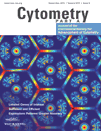|
Conclusion:
|
H-2Dk (or Dk) bearing animals typically increase their frequency of Ly49G2+ NK cells, and end up with lower viral loads 3.5 days after infection. Conversely, H-2Db (or Db) bearing animals typically do not increase this subset and we saw they were then unable to control virus. Overall, the G2+ NK subset had a best-fit relationship with Dk protection against MCMV. However, there were a few H-2k bearing animals that were unable to increase their G2+ population (H-2k atypicals), and their viral loads closely matched those of typical H-2Db mice. Conversely, there were a few Db-bearing animals who increased their frequency of G2+ NK cells, and were able to control virus like that of typical H-2k animals. The G2+ NK cell frequency can still correspond with viral control in animals where Dk is not present. Another genetic factor enabled the NK cells of these Db atypical mice to render some innate MCMV control.
Ly49G2 or I/U intensity had little to no effect on viral load.
High frequency of G2 SP NK cells corresponded well to reduced weight loss, higher frequency of total G2+ NK's, a lower frequency of G2-I/U- (DN) NK cells, and a higher NKp46 MFI in the offspring. However, spleen MCMV correlated the best with altered body weight.
Based on multiple regression analyses, we found that mice before infection who had more DN NK cells and lower G2 MFI had a statistically significant benefit in MCMV protection later. We also found that NKp46 MFI in all NK cells negatively correlated with spleen viral load. So other NK cell surface receptors besides G2likely contributed to overall viral control in these animals.
Licensed G2+ NK cells regulate higher NKp46 MFI in the G2- subset, where its display then best predicts viral control. The unlicensed populations in animals where licensing occurs still play an important role in viral control.
|
|
Comments:
|
A preliminary experiment was performed that showed how NK receptor data analyzed from the blood of a particular mouse (cell frequencies, MFI values) was comparable to the data coming from that same animal's splenocytes. It was after this experiment that we established our system of analyzing NK receptor expression before infection (pre data) via blood, and after infection (post data) via splenocytes, thereby seeing how each animal individually responded to infection. In addition, QTL analysis was done on all of the animals. We already knew the allele of H-2D (and therefore the ability or inability to license Ly49G2 NK cells) would have an effect on viral resistance regarding our animals, but we were interested in what other genetic factors were present.
|

